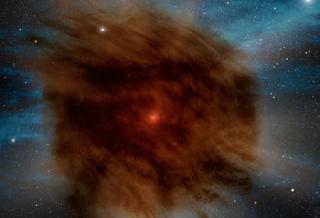
An artistic concept of a giant supernova ending its life with a dust-shrouded whimper. Photo: NASA/JPL-Caltech/R. Hurt
COLUMBUS, OHIO (BNS): A giant star in a remote galaxy ended its life with a dust-shrouded whimper instead of the more typical bang, says NASA.
Researchers suspect that this odd event -- the first one of its kind ever viewed by astronomers – was more common early in the universe.
It also hints at what we would see if the brightest star system in our Milky Way galaxy exploded, or went supernova.
Using NASA's Spitzer Space Telescope, astronomers worked backward to determine what kind of star could have spawned the supernova and how the dust was able to partly muffle the explosion.
They calculated that the star was probably a giant, at least 50 times more massive than our sun. Such massive stars typically belch clouds of dust as they near the end of their existence.
This particular star must have had at least two such ejections, they determined – one about 300 years before the supernova and one only about four years before it. The dust and gas from both ejections remained around the star, each in a slowly expanding shell.
The inner shell – the one from four years ago – would be very close to the star, while the outer shell from 300 years ago would be much farther away.
The findings have been published in the latest edition of the 'Astrophysical Journal'.
 Previous Article
Previous Article Next Article
Next Article












The Indian Air Force, in its flight trials evaluation report submitted before the Defence Ministry l..
view articleAn insight into the Medium Multi-Role Combat Aircraft competition...
view articleSky enthusiasts can now spot the International Space Station (ISS) commanded by Indian-American astr..
view article